Reading Skills Checklist for 1st Grade January
 VectorStock Image
VectorStock Image
READING Information
-
No more than 10 errors per 100 words, including words you had to tell your child, are acceptable.
-
The child must as well demonstrate comprehension. This would exist considered the Instructional level. 94% accuracy and above is the Contained level ~ your kid tin read and comprehend without pedagogy. (In other words, 6 errors or less per 100 words.)
-
Comprehension with the book closed is disquisitional! Grades K and i should retell the story, make a connection to their life or another volume, tell their favorite function and why. Grades ii and up should retell, state the writer'due south lesson, describe the nigh of import outcome, and why.
-
Rate (words per minute) is essential once your child gets to Level I (end of grade one). Calculate that as follows.
| DRA2 Level | Minimum Words Per Minute to Pass DRA2 | Independent Reading Level | Guided Reading Level ~ What Level the Teacher Will Teach At Based on DRA2 | Benchmark Expectation | |
| M | A/1 | A | |||
| 1000 | 2 | A | B | ||
| Chiliad | 3 | B | C | June | |
| 1 | iv | C | D | ||
| 1 | half dozen | D | E | ||
| 1 | viii | E | F | ||
| 1 | 10 | F | Thou | January | |
| 1 | 12 | One thousand | H | ||
| one | 14 | xl wpm | H | I | |
| one | sixteen | 45 wpm | I | J | June |
| 2 | 18 | 55 wpm | J | K | November |
| 2 | twenty | 65 wpm | K | L | March |
| two | 24 | lxx wpm | 50 | Chiliad | June |
| 3 | 28 | 75 wpm | M | N | November |
| iii | thirty | fourscore wpm | Northward | O | March |
| 3 | 34 | 80 wpm | O | P | June |
| iv | 38 | 90 wpm | P | Q | November |
Fiction (F) and Nonfiction (NF) words per minute differ.
| 4 | xl | 105 F | Q | R | March |
| four | 100 NF | ||||
| four | 40 | 105 F | R | South | June |
| 4 | 100 NF | ||||
| v | 40 | 105 F | South | T | November |
| 5 | 100 NF | ||||
| 5 | 50 | 115 F | T | U | March |
| 110 NF | |||||
| five | 50 | 115 F | U | V | June |
| five | 110 NF |
Nonfiction DRA2 options are available for Levels 16, 28, 38, 40, fifty.
**twoscore is listed 3x, and l is listed 2x. The goal is to get a stronger/higher scorer at each assessment point and allow the student to be assessed in fiction and nonfiction at the 40 and/or 50.
Words Per Minute By Month/Course/Level
To summate WPM:
___words in the book divided by ___SECONDS it took to read X threescore = __WPM
For example, say there are 207 words in a book. The child read it in 3 min. 25 seconds, which is 205 seconds. 207 divided by 205 is approximately 1.0 words per 2nd x threescore = 60 WPM!
The above table is from the DRA2 manual and shows the MINIMUM amount of words per minute acceptable to continue to the next level.
| Grade | %ile | Fall WCPM* | Winter WCPM* | Spring WCPM* |
|---|---|---|---|---|
| 1 | ninety | 97 | 116 | |
| 75 | 59 | 91 | ||
| 50 | 29 | lx | ||
| 25 | 16 | 34 | ||
| x | 9 | 18 | ||
| 2 | 90 | 111 | 131 | 148 |
| 75 | 84 | 109 | 124 | |
| 50 | 50 | 84 | 100 | |
| 25 | 36 | 59 | 72 | |
| 10 | 23 | 35 | 43 | |
| 3 | ninety | 134 | 161 | 166 |
| 75 | 104 | 137 | 139 | |
| fifty | 83 | 97 | 112 | |
| 25 | 59 | 79 | 91 | |
| 10 | forty | 62 | 63 | |
| iv | 90 | 153 | 168 | 184 |
| 75 | 125 | 143 | 160 | |
| fifty | 94 | 120 | 133 | |
| 25 | 75 | 95 | 105 | |
| 10 | 60 | 71 | 83 | |
| v | 90 | 179 | 183 | 195 |
| 75 | 153 | 160 | 169 | |
| l | 121 | 133 | 146 | |
| 25 | 87 | 109 | 119 | |
| ten | 64 | 84 | 102 | |
| six | 90 | 185 | 195 | 204 |
| 75 | 159 | 166 | 173 | |
| 50 | 132 | 145 | 146 | |
| 25 | 112 | 116 | 122 | |
| ten | 89 | 91 | 91 |
This tabular array shows approximate percentile ranks for correct words per minute at 3 points during the schoolhouse year.
* WCPM = Words Right Per Minute
To get directly to your child's grade, simply click on the corresponding link above. These expectations come from the Developmental Reading Assessment 2 by Joetta Beaver (2006). Parents, await at what is expected at your kid'southward grade and apply these to reading at home!

Kindergarten Reading Expectations
To Come across the Benchmark, kindergarten students should be instructional at Level C past June. Level B is their contained level.
AT LEVELS A-C,
A Kid'S READING LEVEL IS Determined By:
• Is the child reading with accurateness? No more than one fault per ten words.
• Is the child using the pictures and letter sounds to figure out unknown words?
• Does the child recognize their mistakes and does the child go back to fix them?
• Are they demonstrating an understanding of the directionality of print from left to right?
• Tin they show directionality on two or more lines of text?
• Are they pointing to each word with consistent i:1 matching? (Students tend to estimate or memorize texts at this historic period level.)
• Can the child concord the book and plow the pages independently?
• Does the child demonstrate an agreement of the terms: begins with, ends with, letter, and sound? For example, "Find the give-and-take that begins with this alphabetic character: yard. Find the word that ends with this audio /b/."
Your child will be asked who reads to them at home and to share a title and specific details near a favorite volume. There volition also be a survey given request the child: What books have you finished lately? What are you reading at school now? What are y'all reading at domicile now? What are 3 things you do well as a reader? What are three things you need to work on to become a ameliorate reader?
***When you lot read at dwelling house with your kid, information technology is important to have your child point to each give-and-take and figure out unknown words on their own past:
a. Await at picture b. Expect at the beginning alphabetic character sound c. Sound it out
Always read each volume 3x for fluency and accuracy.
OTHER KINDERGARTEN ASSESSMENTS / REQUIREMENTS
We administer the DIBELS eight 3x/year. Each are 1-infinitesimal tests:
- Name letters. The upper and lower example are mixed up on a canvas of paper.
- Segment individual sounds heard in a word, for case "apple" /a/ /p/ /l/ and "holes" is /h/ /o/ /l/ /z/. If the child tin can correctly segment apple and holes, that is 7 sounds.
- Read 3 letter short vowel nonsense words ~ these tin exist sounded out ~ for example, "sil," "tob," "paj," "zev," "nud." The goal is for the kid to recognize these chunks automatically, not sounding out sound by sound.
- Reading real words ~Kindergarten Trick Words
The minimum scores to pass:
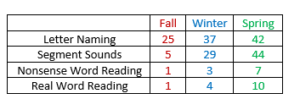
Students should get automatic at reading and spelling these chunks: brusque vowel rimes. For instance, in my reading support group, we practice reading each row rapidly over and over, pointing under each word.
Your kid will besides demand to know how to read and spell the Thousand Trick words. These words tin can't be "sounded out" and need to be recognized by sight: Kindergarten Play a joke on Words.
What Does An ADVANCED Kindergartener Expect Like While Applying Strategies?
| Making Connections/Prior Cognition | Uses background knowledge to enhance comprehension and interpretation. Makes text-to-text and text-to-self connections; uses knowledge of familiar authors to brand predictions. (For ex., Curious George often gets into problem.) |
| Questioning | Asks questions to enhance meaning; can easily respond questions; outset awareness of unlike types of questions ~ literal (answers are IN the text) and inferential (answers come from life feel). |
| Visualizing/Sensory Imagery | Describes own sensory images; images can exist elaborated from the literal text or existing picture; demonstrated using whatsoever modality or media. |
| Determining Importance | Identify words, characters, and/or events as more of import to the overall significant and explain the reasoning. |
| Monitoring Comprehension | Identifies location and blazon of difficulty they had while reading and articulates the demand to solve the trouble. |
| Inferring | Draws conclusions and makes predictions using examples from the text. |
| Retelling | Retells elements of the text in a logical sequence with the book airtight; may include some extension to the overall theme, message, background knowledge, refers to characters by specific names, and uses vocabulary from text. |
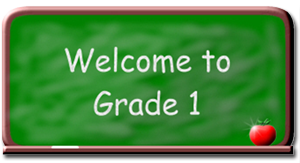
1st Grade Reading Expectations
To Meet the Benchmark, 1st-form students should exist instructional at Level Grand (contained F) past January and Level J (independent I) by June. Therefore, a kid on form level, Meeting the Criterion, may be at the following levels in the following months. Once again, reading is developmental, and these are APPROXIMATE:
September ~ C October ~ D November ~ E Dec ~ F
Jan ~ G February ~ 1000/H March ~ H/I Apr ~ I
May ~ I/J June ~ J
AT LEVELS C – J,
A CHILD'S READING LEVEL IS DETERMINED BY:
• Is the kid reading with acceptable accuracy? No more than ten errors/100 words.
• Starting at Level I, the child is timed. At least 40 Words Per Minute Meets the Benchmark for Level I and 45 WPM for Level J.
• Is the child using various strategies (pictures, letter sounds, word chunks, skip it read on, and go dorsum, asking: Does it look right? Sound right? Make sense?) to figure out unknown words?
• Does the child recognize errors as they read and set them?
• Does the kid read in longer phrases?
• Before the child reads, the child does a "picture walk," which basically ways that the kid looks at each movie before they read. Are they orally connecting with at least iii-iv cardinal events without prompting?
• After reading and with the book airtight, the child does a retelling. Are they referring to the characters by name and including all of the important details from the beginning, middle, end in sequence?
• Does the child use the important linguistic communication and vocabulary from the text in the retelling?
• Can the child retell the story on their own without prompts or questions?
• Tin can the child tell a favorite function and why? We are looking for a response that requires higher-level thinking, for example, inferring the writer's message in the story or stating an action in the text with a personal connection.
• Can the child brand a connection with this text. Does it remind the child of another text, a movie or Idiot box show, or something in their own life? We are looking for connections that testify a deeper understanding of the story. For example, in a fiction story about reusing objects, a connection could be near the importance of recycling.
• If nonfiction, can the child rapidly locate and apply the nonfiction text features to respond questions? (timelines, maps, tabular array of contents, glossary, captions, charts, etc.)
Your child will exist asked who reads to or with them at home and to share a championship and specific details about a favorite book. There will too be a survey given asking the kid: What books have you finished lately? What are you reading at school now? What are yous reading at dwelling at present? What are iii things you lot do well as a reader? What are three things y'all need to work on to go a better reader?
***When you read at home with your child, it is important to have your child signal to each word with i:1 correspondence because students tend to guess or memorize these simpler texts, and your kid should effigy out unknown words on their ain by:
a. Await at picture show b. Sound information technology out c. Skip it, read on, become dorsum
d. Look for familiar chunks in the word; for instance, in "wagon," there's "ag" equally in "bag" and the clamper "on." Always ask yourself, "does that expect right, sound right, make sense?"
Always read each book 3x for fluency and accuracy.
OTHER 1ST GRADE ASSESSMENTS / REQUIREMENTS
Nosotros administrate the DIBELS viii 3x/twelvemonth. Each are 1-minute tests:
- Proper noun letters. The upper and lower example are mixed up on a sheet of paper.
- Segment individual sounds heard in a word, for example "apple" /a/ /p/ /l/ and "holes" is /h/ /o/ /l/ /z/. If the kid can correctly segment apple and holes, that is 7 sounds.
- Read 3 letter curt vowel nonsense words ~ these tin be sounded out ~ for example, "sil," "tob," "paj," "zev," "nud." The goal is for the kid to recognize these chunks automatically, non sounding out sound by sound.
- Reading existent words ~ grade 1 TRICK words
- Oral reading fluency ~ Can the child read x corporeality of words in a story with at least 96% accuracy?
The minimum scores to laissez passer:
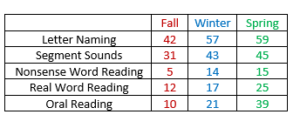
Form ane Play a joke on words for reading and spelling: grade 1 TRICK words
What Does An Avant-garde 1st Grader Look Like While Applying Strategies?
| Making Connections/Prior Noesis | Uses background noesis to raise comprehension and interpretation. Makes text-to-text and text-to-self connections; uses cognition of familiar authors to make predictions. (For ex. Curious George books frequently cease the same way.) |
| Questioning | Asks questions to enhance significant; tin easily answer questions; commencement sensation of different types of questions ~ literal (answers are IN the text) and inferential (answers come up from life feel). |
| Visualizing/Sensory Imagery | Describes own sensory images; images can be elaborated from the literal text or existing picture; demonstrated using any modality or media. |
| Determining Importance | Identify words, characters, and/or events as more than of import to the overall meaning and explain the reasoning. |
| Monitoring Comprehension | Identifies location and type of difficulty they had while reading and articulates the need to solve the trouble. |
| Inferring | Draws conclusions and makes predictions using examples from the text. |
| Retelling | Retells elements of the text in logical sequence; may include some extension to the overall theme, message, background knowledge, refers to characters by specific name , and uses vocabulary from the text. |
![]()
2d Grade Reading Expectations
To Meet the Benchmark, second-course students should be instructional at:
Level Thousand in November (independent J)
Level L in March (contained K)
Level 1000 by June (independent 50)
AT LEVELS K-K
A Kid'S READING LEVEL IS Adamant By:
• Is the child reading with adequate accuracy? No more than 10 errors/100 words.
• The child is timed. At least 55 Words Per Minute Meets the Benchmark for Level K. At least 65 Words Per Infinitesimal Meets the Criterion for Level 50. At least 70 Words Per Minute for Meets the Criterion for Level M.
• Is the kid reading with an expression that reflects the text's mood, pace, and tension?
• Does the child read in longer phrases and heed punctuation?
• After reading the offset few paragraphs, tin can the child make 3 thoughtful predictions of what might happen in the text without peeking ahead at pictures?
• Subsequently reading and with the book closed, the kid does a retelling. Are they referring to the characters past name and including all of the important details from the beginning, middle, end in sequence?
• Does the child use the of import language and vocabulary from the text?
• Can the child retell the story on their own without prompts or questions?
• The child has to tell the author'south message ~ what is the author teaching the states? The child must back up this with text details.
• The child must determine the nearly important event in the story and why, giving an opinion that reflects higher-level thinking.
• If nonfiction, can the child rapidly locate and use the nonfiction text features to answer questions? (timelines, maps, tabular array of contents, glossary, captions, charts, etc.)
Your child will exist asked nearly the types of books they like to read, to tell well-nigh a favorite book, and to tell how they choose a book to read. There will also exist a survey given request the child: What books have y'all finished lately? What are you reading at school now? What are you reading at dwelling house now? What are iii things you practise well as a reader? What are 3 things yous demand to work on to become a better reader?
***When you read at dwelling house with your kid, it is of import to accept your child figure out unknown words on their ain past:
a. Look at picture b. Sound it out c. Skip it, read on, go dorsum
d. Look for familiar chunks in the word; for instance, in "wagon," there's "ag" equally in "bag" and the chunk "on." Ever ask yourself, "does that look right, sound right, brand sense?"
OTHER 2nd GRADE ASSESSMENTS / REQUIREMENTS
We administer the DIBELS 8 3x/year. Each are one-infinitesimal tests:
- Read 3 letter short vowel nonsense words ~ these can be sounded out ~ for instance, "sil," "tob," "paj," "zev," "nud." The goal is for the child to recognize these chunks automatically, not sounding out audio by sound.
- Reading real words ~ Grade two Fob words
- Oral reading fluency ~ Can the child read x amount of words in a story with at least 96% accuracy?
- Maze Comprehension ~ this test is 3 minutes. The educatee reads a story that is missing words. Each time a word is missing, the student selects the correct missing word from a option of 3 words.
The minimum scores to laissez passer:
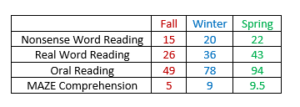
Form ii TRICK words for reading and spelling: Form 2 TRICK words
What Does An Advanced iind Grader Look Like While Applying Strategies?
| Making Connections/Prior Knowledge | Links background knowledge and examples from the text to enhance comprehension and/or estimation. |
| Questioning | Asks and answers different types of questions and finds evidence in the text to support questions and answers. |
| Visualizing/Sensory Imagery | Demonstrates multi-sensory images that extend and enrich the text; sit-in may exist through any modality or medium. |
| Determining Importance | Identifies at least one central idea, theme, or concept, linking it to the text'southward overall meaning. Uses supporting details from the text to explain why information technology is important. |
| Monitoring Comprehension | When stuck, identifies difficulties, articulates the need to solve the problem, and identifies the advisable strategy to solve the trouble, such as using meaning, visual, or structural cues. |
| Predicting/Inferring | Independently makes predictions, interpretations, and/or draws conclusions; and clearly explains connections using testify from the text and personal knowledge, ideas, or beliefs. |
| Retelling/Summarizing/Synthesizing | Retells elements of the text in a logical sequence with some extension to the overall theme, message, or groundwork knowledge, refers to characters by specific name, and uses vocabulary from the text. |
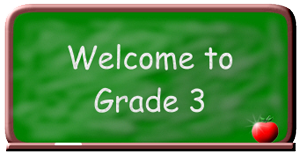
Even if your child is in 3rd, quaternary, or fifty-fifty 5th grade, you tin still read at home with them. Alternate reading pages or paragraphs aloud to each other. Infringe books on tape or CD from the library and have your child follow along, too.
To Meet the Benchmark, 3rd-grade students should exist instructional at:
Level N in November (independent M)
Level O in March (independent N)
Level P past June (independent O)
AT LEVELS N-P
A Kid'Due south READING LEVEL IS DETERMINED BY:
• Is the child reading with accuracy? No more than than ten errors/100 words.
• The child is timed. Level N students should read at least 75 words per minute. Level O and P at least 80 words per minute.
• Is the kid reading with an expression that reflects the text'southward mood, pace, and tension? OR, if the text is nonfiction, is the kid emphasizing fundamental phrases and words?
• Does the child read in longer phrases and mind punctuation?
• Afterward reading the start few paragraphs, can the child brand 3 thoughtful predictions of what might happen in the text without peeking at the pictures ahead? OR, if the text is nonfiction, can the child utilize the title and table of contents page to recall of 3 questions that may be answered in the book?
• After reading the first few paragraphs, can the kid stop and depict each character using 3 specific details? OR, if the text is nonfiction, can the child interpret what a few of the nonfiction text features show?
• Subsequently reading, can the child write a summary, including of import characters, events, and details, from the commencement, middle, end? OR, if the text is nonfiction, tin can the child write important facts from each heading?
• Does the child apply the of import language and vocabulary from the text?
• Can the child answer literal questions?
• The child has to translate the significant of the story and support information technology with details. (For example: What did the character learn? OR Why did the graphic symbol feel____? OR Why did the character say ____?) OR, if the text is nonfiction, a "why do you recollect…" question is asked.
• The child must determine the almost important consequence in the story and why, giving an stance that reflects higher-level thinking.
Your child will exist asked to fill up out a Educatee Reading Survey, which asks: What books have y'all finished reading lately? What are you reading at present at school? What are you reading at home? What are 3 things you lot do well as a reader? What are 3 things you would similar to work on to get a improve reader?
***When yous read at home with your kid, it is important to accept your kid figure out unknown words on their own past:
a. Look at movie b. Sound it out c. Skip it, read on, go back
d. Expect for familiar chunks in the word; for case, in "wagon," there's "ag" as in "handbag" and the chunk "on." Always inquire yourself, "does that await right, sound right, make sense?"
OTHER tertiary GRADE ASSESSMENTS / REQUIREMENTS
We administer the DIBELS 8 3x/yr. Each are one-minute tests:
- Read 3 letter of the alphabet short vowel nonsense words ~ these tin can be sounded out ~ for instance, "sil," "tob," "paj," "zev," "nud." The goal is for the child to recognize these chunks automatically, non sounding out sound by sound.
- Reading existent words
- Oral reading fluency ~ Can the child read x amount of words in a story with at least 96% accuracy?
- Maze Comprehension ~ this test is 3 minutes. The student reads a story that is missing words. Each time a discussion is missing, the educatee selects the right missing give-and-take from a choice of three words.
The minimum scores to pass:
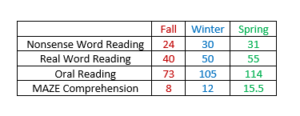
What Does An Avant-garde 3rd Grader Await Like While Applying Strategies?
| Making Connections/Prior Knowledge | Links background knowledge and examples from the text to enhance comprehension and/or estimation. |
| Questioning | Asks and answers dissimilar types of questions; finds evidence in the text to support questions and answers. |
| Visualizing/Sensory Imagery | Demonstrates multi-sensory images that extend and enrich the text; demonstration may be through any modality or medium. |
| Determining Importance | Identifies at least one key idea, theme, or concept, linking it to the text's overall significant. Uses supporting details from the text to explain why it is important. |
| Monitoring Comprehension | Identifies difficulties, articulates the need to solve the problem, and identifies the appropriate strategy to solve the trouble using significant, visual, or structural cues. |
| Predicting/Inferring | Independently makes predictions, interpretations, and/or draws conclusions; clearly explains connections using testify from the text and personal cognition, ideas, or beliefs. |
| Retelling/Summarizing/Synthesizing | Retells elements of the text in a logical sequence with some extension to the overall theme, message, or groundwork knowledge, refers to characters by specific name, and uses vocabulary from the text. |
![]()
Even if your child is in 3rd, 4th, or even fifth grade, you can still read at home with them. Alternate reading pages or paragraphs aloud to each other. Borrow books on record or CD from the library and have your child follow along, too.
To Run across the Benchmark, 4th-grade students should be instructional at:
Level Q in Nov (independent P)
Level R in March (contained Q)
Level S by June (contained R)
AT LEVELS Q-S
A CHILD'Southward READING LEVEL IS DETERMINED By:
• Is the child reading with accurateness? No more than than 10 errors/100 words.
• The child is timed. Level Q students should read at least 90 words per infinitesimal. Level R and South at least 105 words per minute for fiction or 100 words per minute for nonfiction.
• Is the kid reading with an expression that reflects the text's mood, pace, and tension? OR, if the text is nonfiction, is the child emphasizing key phrases and words?
• Does the child read in longer phrases and mind punctuation?
• For Level Q simply, subsequently reading the get-go few paragraphs, tin the kid finish and describe each character using iii specific details? OR, if the text is nonfiction, can the child interpret what a few of the nonfiction text features show?
• After reading the first few paragraphs, can the child make three thoughtful predictions of what might happen in the text? OR, if it is nonfiction, can they make iii predictions of what they might learn in the text?
• For Level R and Due south just, can the kid grade 3 questions from reading the first part of the text? OR, if the text is nonfiction, can the child utilise the title and table of contents page to think of 3 questions that may exist answered in the book?
• After reading, can the child write a summary, including important characters, events, and details, from the commencement, middle, end. OR, if the text is nonfiction, can the child write important facts from each heading?
• Does the child use the important language and vocabulary from the text?
• Tin the child reply literal questions?
• The child has to interpret the meaning of the story and support it with details. (For example: What did the character learn? OR Why did the character feel____? OR Why did the graphic symbol say ____?) OR, if the text is nonfiction, a "why do you think…" question is asked.
• The child must determine the most important event in the story and why, giving an opinion that reflects college-level thinking.
• The child at Levels R and S must check off 1 strategy used to help understand the text. FICTION: made connections, asked cocky questions, visualized, idea of reasons why things happened, understood characters' feelings ~ with 2 examples from the text where the strategy was used. NONFICTION: recalled what they knew about the topic, asked self questions, made connections, decided what was important, thought of why things happened, visualized ~ with 2 examples from the text where the strategy was used.
Your kid will be asked to fill out a Student Reading Survey, which asks: What books take yous finished reading lately? What are y'all reading now at school? What are you reading at home? Think nearly your favorite authors and books. What do yous like to read, and why? What are iii things yous practice well as a reader? What are 3 things you would like to work on to become a better reader? Finally, draw what you plan to do to get a better reader.
***When you read at habitation with your kid, it is important to accept your child figure out unknown words on their own by:
a. Sound it out b. Skip it, read on, go back c. Await for familiar chunks in the word; for example, in "carriage," there'due south "ag" as in "handbag" and the clamper "on" d. Divide words into syllables e. E'er ask yourself, "does that look right, sound right, brand sense?"
OTHER 4th Form ASSESSMENTS / REQUIREMENTS
We administer the DIBELS eight 3x/year.
- one Infinitesimal Oral reading fluency ~ Tin can the child read x amount of words in a story with at to the lowest degree 96% accurateness?
- 3 Minute Maze Comprehension ~ The student reads a story that is missing words. Each time a give-and-take is missing, the educatee selects the correct missing word from a choice of iii words.
The minimum scores to pass:

What Does An Avant-garde 4th Grader Wait Like While Applying Strategies?
| Making Connections/Prior Noesis | Explains how background knowledge enriches the interpretation of the text and begins to make connections beyond life experience and firsthand text. |
| Questioning | Uses questions to challenge the text related to the author's purpose, theme, or point of view. |
| Visualizing/Sensory Imagery | Creates and describes multi-sensory images that extend and enrich the text and tin can explain how those images enhance comprehension. |
| Determining Importance | Identifies at least i key concept, idea, or theme every bit of import in overall text pregnant and clearly explains why. |
| Monitoring Comprehension | Uses more than than one strategy to build pregnant when comprehension breaks down; can articulate which strategies are nearly appropriate for a given text. |
| Predicting/Inferring | Develops predictions, interpretations, and/or conclusions virtually the text that include connections between the text and the reader'due south background knowledge or ideas and beliefs. |
| Retelling/Summarizing/Synthesizing | Stops frequently to reverberate on text meaning; relates to the story or genre personally; can identify key themes; may articulate how this process has created new meaning upon completion of the text. Refers to characters past specific name; and uses vocabulary from the text. |
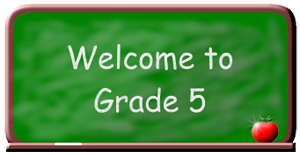
Even if your kid is in 3rd, 4th, or even 5th form, you tin still read at home with them. Alternate reading pages or paragraphs aloud to each other. Infringe books on tape or CD from the library and take your kid follow along, besides.
To Meet the Benchmark, fifth-grade students should exist instructional at:
Level T in November (contained South)
Level U in March (independent T)
Level Five by June (contained U)
AT LEVELS T-V
A CHILD'South READING LEVEL IS Determined BY:
• Is the child reading with acceptable accuracy? No more than 10 errors/100 words.
• The kid is timed. Level T students at least 105 words per minute for fiction and 100 words per minute for nonfiction. Level U and V at least 115 WPM for fiction and 110 WPM for nonfiction.
• Is the child reading with an expression that reflects the text's mood, pace, and tension? OR, if the text is nonfiction, is the child emphasizing primal phrases and words?
• Does the child read in longer phrases, listen punctuation, intermission accordingly?
• After reading the kickoff few paragraphs, can the kid make 3 thoughtful predictions of what might happen in the text and 3 questions they had from reading the first part of the text? OR, if the text is nonfiction, can the child utilize the title and tabular array of contents folio to recall of 3 questions that may be answered in the book and 3 predictions of what might they larn in the balance of the book text?
• Later reading, can the kid write a summary, including of import characters, events, and details, from the outset, middle, end? OR, if the text is nonfiction, can the child write of import facts from each heading.
• Does the child employ the important linguistic communication and vocabulary from the text?
• Can the child answer literal questions?
• The kid has to interpret the meaning of the story and support it with details. (For example: What did the grapheme learn? OR Why did the character feel____? OR Why did the character say ____?) OR, if the text is nonfiction, a "why practice y'all remember…" question is asked.
• The child must determine the most important event in the story and why, giving an opinion that reflects higher-level thinking.
• The child must check off a strategy that they used to help empathize the text. FICTION: made connections, asked self questions, visualized, thought of reasons why things happened, understood characters' feelings ~ with 2 examples from the text where the strategy was used. NONFICTION: recalled what they knew about the topic, asked self questions, fabricated connections, decided what was important by using headings, thought of why things happened, visualized ~ with ii examples from the text where the strategy was used.
Your child volition exist asked to make full out a Student Reading Survey, which asks: What books take yous finished reading lately? What are you reading at present at school? What are you reading at abode? Retrieve most your favorite authors and books. What do yous like to read, and why? What are 3 things you do well as a reader? What are 3 things you would like to work on to become a amend reader? Finally, describe what you program to do to become a better reader.
***When you read at abode with your child, it is important to have your child figure out unknown words on their own past:
a. Audio it out b. Skip information technology, read on, go back c. Look for familiar chunks in the word; for example, in "wagon," there'south "ag" as in "bag" and the chunk "on" d. Divide words into syllables east. Ever ask yourself, "does that look right, sound right, make sense?"
OTHER 5th GRADE ASSESSMENTS / REQUIREMENTS
We administrate the DIBELS 8 3x/year.
- i Minute Oral reading fluency ~ Tin the kid read ten amount of words in a story with at least 96% accuracy?
- iii Minute Maze Comprehension ~ The student reads a story that is missing words. Each time a word is missing, the student selects the correct missing give-and-take from a pick of 3 words.
The minimum scores to pass:

What Does An Avant-garde 5th Grader Look Like While Applying Strategies?
| Making Connections/Prior Knowledge | Explains how background knowledge enriches the estimation of the text and begins to make connections beyond life experience and immediate text. |
| Questioning | Uses questions to challenge the text related to the writer's purpose, theme, or point of view. |
| Visualizing/Sensory Imagery | Creates and describes multi-sensory images that extend and enrich the text and tin explain how those images enhance comprehension. |
| Determining Importance | Identifies at least one key concept, idea, or theme every bit important in overall text meaning and clearly explains why. |
| Monitoring Comprehension | Uses more than one strategy to build pregnant when comprehension breaks down; can articulate which strategies are most appropriate for a given text. |
| Predicting/Inferring | Develops predictions, interpretations, and/or conclusions about the text that include connections between the text and the reader's background knowledge or ideas and beliefs. |
| Retelling/Summarizing/Synthesizing | Stops frequently to reflect on text pregnant; relates to the story or genre personally; tin identify key themes; may articulate how this procedure has created new meaning upon completion of the text. Refers to characters by specific name and uses vocabulary from the text. |
 A Word doc of this folio is available with a $10 donation for my website maintenance fees. No graphics due to copyright laws. Thanks!
A Word doc of this folio is available with a $10 donation for my website maintenance fees. No graphics due to copyright laws. Thanks!
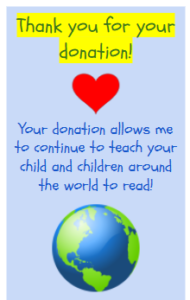
Copyright 05/04/2012
Edited on 02/twenty/2022
References
I did not write those wonderful blurbs of what advanced students look like at each form level. They came from an unknown source.
DRA2 Teacher Transmission from Pearson Publishing, 2006.
Copyscape alerts me to duplicate content. Delight respect my piece of work.

Source: https://www.mrsjudyaraujo.com/expectations-by-grade-level/
0 Response to "Reading Skills Checklist for 1st Grade January"
Post a Comment